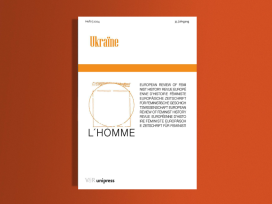 It is Monday morning and crowded. People from pretty much all over the world are waiting their turn to get help and support. First there is an introductory chat in the waiting room. Do you need help with your work permit or visa? Do you have difficulties with housing, your children’s schooling? Or do you need to take language classes? At Centro de Información para los Trabajadores Extranjeros (CITE), info-centre for foreign workers, everything is collected in one place. Questions on permits, legal aid and union issues are all taken care of by the union representatives. The social issues are dealt with by the Red Cross, and a separate organization arranges the language classes. After an initial informational conversation you go upstairs to those who can provide the necessary support and advice.
It is Monday morning and crowded. People from pretty much all over the world are waiting their turn to get help and support. First there is an introductory chat in the waiting room. Do you need help with your work permit or visa? Do you have difficulties with housing, your children’s schooling? Or do you need to take language classes? At Centro de Información para los Trabajadores Extranjeros (CITE), info-centre for foreign workers, everything is collected in one place. Questions on permits, legal aid and union issues are all taken care of by the union representatives. The social issues are dealt with by the Red Cross, and a separate organization arranges the language classes. After an initial informational conversation you go upstairs to those who can provide the necessary support and advice.
The number of CITE’s across the country has grown explosively as the rate of foreign workers coming to Spain has increased. Comisiones Obreras (CCOO) is one of two greater trade union confederations in the country, the other one is Unión General de Trabajadores (UGT). Ghassan Saliba Zegondhi at CCOO:s union office estimates that Spain currently has three million immigrants. In addition at least 800 000 so called undocumented, that is to say those who work without permits, those we can see in hard hitting news reports showing boats filled to the rim with people. Or those less noticeable who come by plane from Peru, Bolivia, China, or the Philippines, not seldom duped to come here on false premises by shady businesses. Spanish right wing governments have consciously played on xenophobic sentiments, and in 2001 a law was passed which in practice deprived undocumented of their civil rights, such as the right to demonstrate and express their opinions. In addition, the law prohibited individuals and organizations from providing undocumented with support and help.
“We decided to put the foot down”, Zegondhi states. “We need immigration. The union must change and become a multicultural union. The illegals must obtain their papers and permits and we are working hard to get them to organize into unions. That is our vision.”
In Catalonia alone, an autonomous region in Spain’s north-east corner, there are 46 CITE:s and in the whole country there are 146 union centres like the ones in Barcelona and Berga. But it is an enterprise which works in breach of the law. Because here at Avenida Parallel the union admits everyone; those with documents and those without. “We simply ignore the law”, says Zegondhi. “It infringes on human freedoms and rights. We are on the exposed workers’ side and it makes no difference if you are one of our members or not. If you need help, you get help.”
The dense weave of CITE across the country is also a hub for CCOO:s alliances with other union organizations, such as UGT, social movements such as SOS Racismo, and individual organizations such as the Red Cross, the catholic Caritas and many more. In 2005, the movement endorsed by the union coerced “amnesty” for 600 000 undocumented workers who in a single sweep became part of the ordinary job market.
On occasion, the broad and unifying alliances sweep across Spain like giant waves. When the fight is won or for other reasons over they step back and disappear. It is a southern European tendency which occasionally also surfaces in other countries, such as France, most recently when thousands of “Collectifs“, wide-ranging local alliances around the country, managed to create public opinion and a movement which lead to a decisive “no” in the referendum on a European constitution in 2005. And as in Italy that same year when the country’s six different union organizations gathered in a nation-wide general strike directed toward the Berlusconi administration’s corrosion of the welfare system. This ability to mobilize is a part of a South-European tradition which has proved to be very powerful in defending migrant workers’ rights.
Another defining feature – apart from the civil disobedience which CCOO exhibit and which is evident in the unconditional support for migrants’ civil rights – is political inventiveness. Perhaps one might call it organizational agility; the capacity to create new momentary structures and adapt to whatever new situations a current issue demands. Such as, for example, CITE.
Bridge between union and immigrant
Another example is Associazione Nazionale Oltre Le Frontiere (ANOLF), the organization created by the Italian trade union confederation Confederazione Italiana Sindicati dei Lavoratori. ANOLF is a broad, democratically constructed movement with migrants as members, more than 45 000, from a number of different countries. It was founded in 1989, three years after Spain’s first CITE was created, with the purpose of fighting racism and xenophobia. CITE offers migrants legal advice and social services, and works actively to encourage migrants to join a union. ANOLF is a structure aimed at organizing and mobilizing migrants so they can defend their civil rights, but it is also aimed at creating a “bridge” to unions and other organizations. The idea and strategy is, in other words, that the union supports migrants’ self-organization.
ANOLF also functions in some way as a set of info-centres. Throughout the country there are eleven offices from which migrants are informed of their civil rights, given legal aid and advice and offered Italian courses, and where broad alliances with other organizations and movements supporting social and civil rights of migrants are mobilized.
Regarding trade union issues, there is a connection and close co-operation between ANOLF and the trade union confederation CISL, similar to the one between CITE and CCOO. When a worker from another country, with or without documents, is in trouble at his workplace, he can get in touch with ANOLF. The strength and credibility of the organization lies not least in its connections with the migrants’ own networks, simultaneously functioning as a “bridge” and crossing over to being a union. ANOLF can deal with some questions on their own, others are channelled to the union. With ANOLF, CISL has created a structure that crosses the divide between a trade union which is stuck in its own traditions and thinking with limited information on other cultures, and those migrant workers who come to a new country and for whom the distance to a trade union is substantial.
CCOO’s Ghassan Saliba Zegondhi returned time and again during our meeting to the organization’s “vision” and “strategy”. The first information agency was also the result, he argued, of a more comprehensive decision that CCOO itself should modify; the union is to be “Multicultural” and must become a more open and pluralist one, and it needs to change its manner of carrying out union activity. CITE exists, in other words, for its own sake, as a hub in a wider movement to defend exploited workers’ rights. But it also functions as a lever for a more in-depth transformation of the own organization.
Unionist street fighters
The international tendency with growing private service sectors, with many and small workplaces, combined with an increasingly comprehensive informal economy is also evident in Europe. It is at such workplaces that migrant workers often earn their livelihood, as do women and youngsters. The trade unions are at their weakest where migrant workers work, for example within agriculture, and strongest within the public sector and industries with large workplaces.
So Wim Balthussen and Irek Podgourni of the Dutch FNV Bondgenoten go against the current in more ways than one. They call themselves the street-fighters of unions, use tough classic union approaches, and go in all guns blazing to organize those whom many of their colleagues in other trade unions around Europe consider impossible to organize. “We organize rural workers” Wim and Irek say simultaneously. “Most of them are from Poland, but more and more are also from Romania. They face problems with everything: wages, working hours, anything you can imagine, and it concerns big money, not least for the employers – the farmers – whose interest lies in not meeting their demands.”
Imagine yourself working seven days a week, perhaps fifteen hours a day and not even having time to shop for groceries. We have even seen how people are forced to live off the vegetables they pull out of the ground. Or we witness how employers systematically recruit in Poland through ads saying that they will be paid through special accounts when they get back home, yet when they have worked half a year or so the promised money is not in the account. So union enforcement is a demand, and such enforcement can not be achieved by single individuals, they must unite, it must be done collectively. Simple, really.
“So we go on strike”, Wim says and laughs. “No, we get them organized, make demands, and if none are met by the farmer – strike. There is no other way.” Wim continues:
We hang around outside the shops where we know the Poles buy their food on Saturdays, we tell them about their rights and give them our cell phone numbers. We tell them: talk to each other, get organized. When they have decided and put forth their demands, that is when Irek and I enter the scene and negotiate for them. We know the language, the rules, we know how to negotiate. It is always a matter of short, quick operations. A strike, if everything works out, is a matter of twenty four or so hours. They have to realise that we can’t solve their problems, we can only help them on the way. It is not enough that one, or three, say yes, everyone has to be involved, they have to talk together. The decision to fight has to be their own. But if we stick to the regular procedures it is talk, talk, talk, and then to court, but at that point of course the workers have already been fired and returned to Poland. Often, they are just here a couple of months at the time, so we have to act quickly, with actions and strikes, otherwise it will, as mentioned, just end up in a bunch of talk. We have to work under ground. Here in the Netherlands we talk of “meat-Poles” and “lettuce-Poles”, those who work at the abattoirs or in agriculture. The butchers are usually temporarily employed, the employers in that field are also more concerned about their reputation, so for the meat-Poles it is usually a matter of unionist agitation, of organization. For the lettuce-Poles it is a matter of quick actions and strikes. There are differences and the approaches have to vary, but at the same time the unions are touchy about these things and not everyone approve of what Irek and I are doing.
Wim Balthussen and Irek Podgourni keep returning to the union activity for those working in the fields in Netherlands in some way going “under ground”. They are forced to do a lot which is not legal, which goes against work-right regulations and is reminiscent of the Spanish CCOO:s civil disobedience. This is at the same time a reflection of the union conditions brought about by an “in-formalized” economy.
André Fadda, elected into CGT at the shipyard in French Saint-Nazaire, also talks about a unionized underground. The shipyard signs contracts with an employment agency who in turn contracts another, all the way down to a third and fourth part. It is incredibly difficult for André and other elected officials to get a clear grasp of the employment conditions, and one doesn’t really know with whom to negotiate. Moreover, the hierarchy of subcontractors operate in a legal grey area with uncertain legislation, making the negotiations in the French prud’hommes, the local labour courts, unpredictable and drawn out. The firms that sublet foreign manpower are not uncommonly fake businesses; they carry their office in their pocket and to André Fadda and the others this means major detective work.
We organize them; primarily Poles and Romanians. Sometimes they don’t get paid at all, they are forced to work 50-60 hours a week. There is a great sense of fear, and language difficulties add their own problems. We seek them out, usually where they eat and sleep. At the workplaces the risk of them getting fired is too great. We work entirely under ground. We organize strikes – in 2005 there were 8 strikes among the Poles – and we turn to the press to disgrace the employers. We network a lot among other movements, with human rights organizations and immigrant associations, and we collaborate a lot with Solidarnosc. Ten years ago we were fifteen thousand full time employees at the shipyard, now we are six thousand and an increasing number are getting temporary jobs through the employment agencies. Our primary demands? Stronger legislation in Europe on subcontracting – the current situation is one of total lawlessness!
So, are André Fadda’s, Wim Balthussen’s, and Irek Podgourni’s union practices representative of the trade unions of Europe? No, would have to be the straight answer, an answer which at the same time doesn’t really do justice to the change taking place and which furthermore conceals a great span of perspectives and practical activity between different trade unions. In an extensive questionnaire introduced by the European Trade Union Confederation (ETUC), which was answered by twenty four national trade union confederations, practically all conceded that migrants are harder hit than others in working life, particularly women. But only slightly more than half of them, thirteen out of the twenty four confederations, have any form of strategy to increase the number of migrants and ethnic minorities among their members. Flyers, pamphlets, home pages, ads and other campaigns are the most important elements to such strategies. That is to say not the type of offensive, visiting, and organizing activity carried out by Fadda, Balthussen and Podgourni. The three confederations which most obviously stand out and break the mould of strategies dominated by informational activity, are CCOO, with its CITE, CSL in Italy with ANOLF, and also Trade Union Congress (TUC) in England, who have clear rules on affirmative action to members of foreign descent. Furthermore, nearly all confederations, twenty two out of twenty four, have employees with specific responsibilities for migration and ethnic minorities, while the number of people employed varies greatly, from thirty (Italian UIL) to one part-time post (the Danish trade union confederation LO).
To the question of whether advice and support is given also to migrant workers who are in the country without residence and work permits, only eleven out of twenty four answer with an absolute yes. The Finnish SAK, the Norwegian trade union LO, and the Swedish LO reply with a no, Danish LO doesn’t even give an answer, while all unions in southern Europe say yes. A clear division in the attitude towards the “undocumented” is in other words drawn between a unionist south and a unionist north. An alarming number, nineteen out of twenty four confederations, also claim that “insufficient language skills” is the primary reason why migrant workers are harder hit by unemployment, low wages, and harassment at work. It is a relationship which raises the question of what type of analysis the confederations’ practices are based on, particularly as only thirteen out of twenty four suggest having any strategy around work with migrants at all. Few, if any, trade union confederations (except possibly TUC in England) use the same clear language as CCOO in Spain, whose strategy has lead to 146 information agencies for all workers regardless of whether they have their papers in order or not. CCOO also speak of the need to change and become a pluralistic and multicultural union. They indicate having a vision for which work with and for migrant workers is a defining precondition. At the same time, documents and congress resolutions speak their own clear language. European trade union without borders is a one page document with some brief and decidedly concrete theses, which was signed as early as 1999 by all of the member organization presidents in the ETUC:
– Europe is becoming an increasingly allied economy and job market, which implies that national assemblies and central organizations are “Europeanizing” by placing priority on cross border activity through the European Trade Union and by means of the European industry organizations.
– A cross border solidarity is necessary to defend workers’ equal rights regardless of nationality and what national assembly they are organized in.
– A trade union “chart” is to be drafted which clarifies these rights and which emphasises the way in which the member organizations of ETUC are to act on them.
The direction is unequivocal. The trade unions of Europe know no national borders. National trade union restraints which may inhibit cross border solidarity are to be removed. The members of ETUC vow to, with this intent, operate increasingly through the ETUC and the European trade union industrial federations.
But when I stroll through the trade union corridors of Brussels I hear sighs and groans over the reluctance shown by the national trade unions and confederations to live up to ideals and resolutions. We all have our differences they say, but far too many come to Brussels, take part in the decision making and then return home to do as they always have. The frustration here is great, and comes from the strong and enduring national restraints which transform far too many decisions to hollow phrases. Still, the frustration among the central organization and ETUC functionaries reflects an equally strong desire to really achieve something. In the middle of all the rigidity and conservatism, awakenings occur, sparks shoot from ever new trade union practices.
The good examples
At Elewijt, the Belgian Metal industry trade union’s conference centre, right outside of Brussels, thirty elected officials from sixteen countries, invited by ETUC, meet to compare notes. Those who are here represent, as ETUC sees it, the good examples, “the best practical examples of how one can reach out to migrant workers”, of trade union work with migration and cross border activity.
Interregional Trade Union Councils (ITUC) is an unfamiliar factor in Sweden, even among officials in LO and its associations. Still, they play an important role to all those who on a daily basis, or for shorter periods of time, move across the borders. On the borders between Germany, Luxembourg, Belgium, and the Netherlands, hundreds of thousands of people live in one country and work in another, at least over short periods of time. On the Polish/German border alone there are three trade union councils formed by German DGB, and Solidarnosc, OPZZ and FZZ in Poland. In total, there are forty two such councils in Europe.
One of them is ITUC Burgenland-West-Hungary. The difference in salary between Austria and Hungary is one to three, explains Eszter Toth from Österreichischer Gewerkschaftsbund (ÖGB). There is a strong pressure on coming to Austria to work on farms, in hotels, and restaurants. Ten percent of all employed in the Austrian province of Burgenland, around 80 000 people, are Hungarian, and most of them commute. Most can’t speak German, know little about their rights, and are often exploited. The council, Eszter Toth continues, respond with actions along the border, flyer distribution, visitations, counselling, and organizing of members.
ITUC – Trois Frontiers (“three borders”), is an interregional council that unites France, Germany, and Belgium, and who, through Alain Succart, has the say. Common industries are coal and steel, the conditions throughout the different regions are similar, yet the need for counselling and information is big. Succart’s explanations, as also Toth’s from ÖGB, concerns much less “street-fighting” and underground unionist struggle, and considerably more common everyday union work. At the same time, their accounts speak of the divergence within the interregional councils’ activities around the national borders of Europe: it is not just a matter of information and harmless counselling. This is also where unionized bridges between countries and locally elected officials are built. During the coffee breaks they talk about war memories that have survived along the borders, seeing as the trade union councils are positioned on the borders that were crossed by troops not too long ago, and they talk about a reborn xenophobia.
Another way to operate is through separate trade union confederations, like for example Finnish SAK which in 2002 established an agency for union information in Tallinn. The intention is to develop cooperation between job markets and avoid social dumping through collaborative work between the confederations. The information agency serves to inform about conditions on the Finnish labour market – including the employee’s rights – through counselling, a web page, and seminars.
Ina Atanasova from Bulgarian KNSB, talks about similar types of trade union information agencies. There are today at least 50 000 Bulgarians in Spain “illegally, and more are coming, and no one knows anything about their rights”. From Romania, Daniela Radu from Cartel Alfa says the current of migrants is mainly moving towards Italy, causing the same type of information agencies to be established in Bucharest.
In Tallinn, as in Sofia and Bucharest, the cooperation between the countries’ confederations is in focus; a bilateral collaboration for mutually beneficial information which also reaches outside of the EU borders. At the seminar, some representatives from the Spanish CCOO mention union co-operation between the trade unions in Andalusia and the Moroccan trade union confederation Union Générale des Travailleurs du Maroc (UGTM). In cities such as Seville, Cadiz, Huelva, Tangiers, and Ceuta, union activists from each country meet to co-organize counselling for undocumented workers from Morocco and plan upcoming actions to organize members. ANOLF has information agencies not only in Italy but also one in Morocco and another in Senegal.
Finally, a third type of “best practical examples”, focuses on organization and trade union struggle. André Fadda’s, Wim Baltuhussen’s and Irek Podgourni’s under ground fights are an example of such a practice. At the seminar, Sean Bamford from TUC says that the average degree of organization in Great Britain lies at around twenty four percent, but for migrants it is at two percent. It is important to understand, he continues, that most of them work in fields that have always been difficult to organize, such as agriculture and the service industry, jobs which have always had the lowest position in the “worker hierarchy”. He states with emphasis that most trade unions in England and Europe take shortcuts and have difficulty rethinking.
An Anglo-Saxon union triangle
There are however exceptions. T&G (who in the spring of 2007 united with Amicus and formed Unite – the Union) in England is one of them. The association has employed eight Polish organizers who work solely with recruiting members among their own countrymen. It is an association which invests big money and resources in organization in a way which is reminiscent of classic union pioneer work, but which in another way is different and innovative. There is an Anglo-Saxon union triangle of close contacts which exchange experience and inspiration between England, USA, and Australia/New Zealand. When Nigel Costley, head representative at TUC South West in Bristol talks of the association Polski-Bristol and London Citizens, or when Kevin Pass, chief organizer at T&G in the outskirts of London describes how he organizes migrant workers in the meat industry, many ideas on new unionism, or organizing unionism, strategies and methods for organization of new members, can be linked to the US, in particular to California and the trade unions SEIU and UNITE HERE.
“British unionism is a mirror of society”, Nigel Costley says, when I meet him at the union office in Bristol some weeks after the seminar i Brussels:
It is growing old and needs new, fresh blood. In the migrant communities, which are now popping up like mushrooms in Great Britain, there are many young, energetic workers who will revitalize the union. If we only do the right thing. To the East Europeans, given their background, confidence is something very important. Particularly to the Poles, their church here in Bristol plays a crucial role, and when they see us in church, see that we work with unionism through the church, they can begin to confide in us. An association like Polski-Bristol, the one established by the church here, is much more useful to us (as a recruitment site) than if we were to hang around outside the workplaces and hand out pamphlets. It’s not just the Polish who have their own associations, it goes for the Ukrainians, the Russians, and the Romanians as well, with associations like Ostaja, Ukrainian Club, PAA, and others. So what we do now is to support them in their self-organizing, for instance by helping them create networks between the different immigrant fellowships.
Kevin Pass at T&G talks, on his part, less about the need for alliances and more on how unionism must rediscover its roots and above all recruit new members. By the mid-seventies, the English trade union movement had 13.5 million members. By now it is down to 6.5 million. Organization is a matter of survival. And no other association invests as much resources on organization as T&G. Eighty full-time employees do nothing but, according to the American model, organize new members. To Kevin Pass, the organization of the difficult workplaces – those in the private sector and within an ever increasingly informal economy – is basically the same thing as the organization of migrants, since they are the ones forced to take the jobs on the very bottom, the jobs nobody else wants. But when he speaks of organization, it isn’t as one imagines it being in the past – someone gets up in the back of a pickup, furious about an injustice, starts agitating, and then a spontaneous show of hands on the spot to form a trade union. T&G utilize a system based on careful investigation by the association’s examiner of the field to be organized, of employers, their weaknesses and shortcomings, and everything that may serve as a basis for T&G’s organizers. Not everything T&G does is copied from SEIU in USA, differences in tactics and strategies do occur.
Organize or die in California
The influence, however, from the country where union depletion and membership drop has been the greatest we know, the country where union battles over a long period of time have been the toughest and where the employers are more non-unionist than in many other countries, is distinct. The US is also the country, perhaps precisely because of this background, where union experiences of, and strategies for organization of migrants, is most explicitly developed.
Parts of the North American trade union movement has been reborn. SEIU and UNITE HERE are the two associations which to a greater degree than others have appropriated an old-school, aggressive, confrontational, and more strategic practice. They are also associations which have occasionally been exceptionally successful in the organization of new members, primarily migrant workers. The associations’ experience shows that the renewal required to successfully organize new members on a greater scale demands a combination of the following factors: a crisis within the organization which creates pressure and necessity for new union renewal, forceful and strategically founded support from the own union, as well as access to expertise and experiences from outside the unionised structure and culture. Revitalized old tactics and union methods have been put to use, which stress mobilization of labourers and members, coercion on arenas outside the workplace, and strategic planning.
One tactic is what is normally referred to as rank and file intensive strategy, and which implies that the trade union forms specific labour committees which in turn employ a visiting activity door to door canvassing. Furthermore, such a strategy emphasizes strong, poignant issues of justice and dignity, rather than more secluded issues of wages and work hours. But there is also emphasis on common symbols and symbolic acts, as in wearing badges at work that state that one is a union man or woman.
A second tactic is what is referred to as corporate campaign, and which, sure enough, indicates that the arena for union fights is broadened to not only include the workplace and the production of goods and services. Here, the union does extensive investigation into a corporation’s economy, structure, contact range, and into financial or other weaknesses that could be of use. It concerns, for example, who owns stock and which interests and weaknesses they in turn have. These investigations are followed by creating public opinion to disgrace a corporation or to in other ways influence groups within the corporation’s sphere of interest.
A third tactic implemented is strategic planning to evaluate which corporations are fit for organization. Earlier, a traditional hot shop-tactic was implemented, that is to say, the union chose to venture into a workplace which was hot due to some conflict. Now, corporations are chosen on the premises of very careful analysis and a strategic evaluation of where an effort would do most good.
A fourth union tactic, finally, is to side-step the statutory process which is required in the United States for a trade union to gain legal validation, a procedure which largely is run according to the terms and conditions of the employers. Instead a tactic is chosen which involves mobilization of power and direct confrontation with the employer.
Only those unions which use the full register of these new strategies succeeded in organizing new members. But this has, at the same time, postulated a retrial of the organizations’ own structure, culture and working methods. A break from the trade union as male, pale and stale, is a prerequisite. Another condition is access to expertise, knowledge, and experiences from outside the union, and it has become evident that within, above all, SEIU, but also UNITE HERE, one has consciously and over a period of about twenty years, employed young activists from other social movements. They are activists with a differing perspective on unionist democracy, a different emphasis on pluralism and diversity, a diversity-attitude which breaks down patriarchal top-down administration and aged white men’s tradition-laden dominance within American trade unions. They illustrate how intellectual expertise (such as careful investigation) can be used in the unionist struggle, but also provide experience with broad alliances with other movements. It is when the union, without claiming superiority, has joined hands with other groups, like California Immigrant Workers Association (CIWA), or Hermandad Mexicana, that success has been possible.
The future for the European trade union
European Migrant Workers Unions (EMWU) can possibly serve as an example of consciously organized discrimination. It is a choice which could, in the worst case, imply that the established union chooses separate solutions for separate “categories of workers”, a strategy which nourishes segregation and the formation of separate trade unions for migrants, a kind of European trade union light for the Polish, Romanians and Bulgarians, for instance. EMWU was formed in 2004 by the German construction union IG BAU. Seventy five percent of its approximately 1500 members are Polish, fifteen percent are Romanian, and the rest come from Bulgaria and other Eastern European countries. Furthermore, EMWU has three types of membership: full membership, associated organizations, and single members without voting rights.
The first category includes those from IG BAU, the German native construction workers who formed the new organization and are legible to vote. The other category is other union organizations in other countries, such as the Polish construction union ZZPR. The members without voting rights (support-members, in German Fördermitgleider), are indeed the migrant workers.
The new organization is a seam in IG BAU:s campaign Ohne Regeln geht es nicht (“without rules it will not work”), a version of the Swedish trade union confederation LO campaign Ordning och reda på den svenska arbetsmarknaden (“Order and conduct on the Swedish job market”). The idea is to, by organizing migrant workers in this way, better be able to assist union-wise, and thereby also prevent underbidding rivalry and social dumping. The tension is strong between native construction workers and “those who come here and take our jobs” in Germany.
Finally: the trade union is at a crossroad. Either one chooses to try new or revived classic methods of organizing migrant labour, methods which according to the North American experience, or the Italian and Spanish, also requires and implies a transformation of the trade union as a whole. Or one chooses a direction which doesn’t indicate any retrials of accustomed structures and cultures, and thereby risk to consolidate and widen the distance between those working in the informal vs. the formal economy, between the white and male dominated worker aristocracy and the poor, brutally exploited migrant worker.
This text is an excerpt from the author’s book I skuggan av en storhetstid, about the trade unions of Europe, to be published in September 2008. Ed. note.

 It is Monday morning and crowded. People from pretty much all over the world are waiting their turn to get help and support. First there is an introductory chat in the waiting room. Do you need help with your work permit or visa? Do you have difficulties with housing, your children’s schooling? Or do you need to take language classes? At Centro de Información para los Trabajadores Extranjeros (CITE), info-centre for foreign workers, everything is collected in one place. Questions on permits, legal aid and union issues are all taken care of by the union representatives. The social issues are dealt with by the Red Cross, and a separate organization arranges the language classes. After an initial informational conversation you go upstairs to those who can provide the necessary support and advice.
It is Monday morning and crowded. People from pretty much all over the world are waiting their turn to get help and support. First there is an introductory chat in the waiting room. Do you need help with your work permit or visa? Do you have difficulties with housing, your children’s schooling? Or do you need to take language classes? At Centro de Información para los Trabajadores Extranjeros (CITE), info-centre for foreign workers, everything is collected in one place. Questions on permits, legal aid and union issues are all taken care of by the union representatives. The social issues are dealt with by the Red Cross, and a separate organization arranges the language classes. After an initial informational conversation you go upstairs to those who can provide the necessary support and advice.




